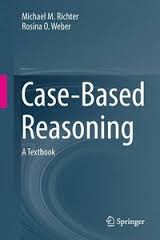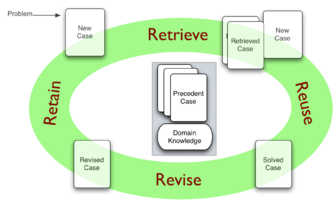Case-Based Reasoning
Materials for CS.367 CS.760 & CS.767
(parts adapted with
permission from Ashwin Ram's course at Georgia Tech)
Case-based reasoning (CBR) is a family of artificial intelligence
techniques, based on human problem solving, in which new problems are
solved by recalling and adapting the solutions of similar past
problems. CBR is an active area of research and has also been adopted
by many companies such as AT&T, British Airways, Cisco,
Daimler,
Benz, Dell, GE, Intel, Lockheed, Nokia, Siemens, and Visa, to name but
a few.
What is all the excitement about? What is CBR, how does it work, how is
it applied, what research is ongoing to improve it? We'll discuss a
range of topics: case representation, indexing and retrieval,
similarity
assessment, adaptation, and learning. In addition you'll about what
motivates and drives a research community and how that community
collaborates to move the research area forward.
Essential Texts
Recommended Texts
- J.L. Kolodner (1993).
Case-Based Reasoning. ISBN 978-1558602373.
- D.B. Leake (1996).
Case-Based Reasoning: Experiences, Lessons, and Future Directions. ISBN
978-0262621106.
- I. Watson (1997).
Applying Case-Based Reasoning: Techniques for Enterprise Systems. ISBN
978-1558604629
- Proceedings of ICCBR
(International Conference on CBR) and ECCBR (European Conference on
CBR), published by Springer-Verlag in the LNCS series (in the library)
- Belen Diaz Agudo & Ian Watson (Eds.), 2012. Case-Based Reasoning Research and Development - 20th International Conference, ICCBR 2012 Lyon, France, LNAI 7488 Springer.
Lecture Notes
All in Acrobat pdf format. Note: not all presentations or all
slides within a presentation may have
been used during the lectures but they're all interesting. They also may not be given in the order below.
Background Reading
- Case-based
reasoning: Foundational issues, methodological variations, and system
approaches (Agnar Aamodt & Enric Plaza,
AI-Communications, 1994)
- Aha, D. W. (1998). The Omnipresence of Case-Based
Reasoning in Science and Application. Knowledge-Based
Systems, 11(5-6), 261-273. (Companion
paper for an invited talk at the Seventeenth SGES International
Conference on Knowledge Based Systems and Applied Artificial
Intelligence) (pdf) student presentation
- DW Aha, M Molineaux, & M Ponsen (2005), Learning to win. ( pdf ) student
presentation
- Aha, D.W. (1991). Case-based learning algorithms. Proceedings of
the DARPA Case-Based Reasoning Workshop (pp. 147-158). Washington,
D.C.: Morgan Kaufmann. ( pdf )
- Wettschereck, D., Aha, D. W., & Mohri, T. (1997). A
review and comparative evaluation of feature weighting methods for lazy
learning algorithms. Artificial Intelligence Review, 11,
273-314. Also available as Technical Report AIC-96-006: Washington, DC:
Naval Research Laboratory, Navy Center for Applied Research in
Artificial Intelligence. ( pdf ) student presentation
- Watson,
I., (1999). CBR is a methodology not a technology. In, the Knowledge
Based Systems Journal, Vol. 12. no.5-6, Oct. 1999, pp.303-8. Elsevier,
UK. (pdf)
student presentation
- Smyth, B. & McKenna, E. (2001). Competence guided incremental
footprint-based retrieval. Knowledge-Based Systems
Volume 14, Issues 3-4, June 2001, Pages 155-161 ( pdf ) student
presentation
- Categorizing Case-Base Maintenance: Dimensions and
Directions David B. Leake and David C. Wilson. Advances in
Case-Based Reasoning: Proceedings of EWCBR-98, Springer-Verlag,
Berlin. ( pdf )
- DB Leake & DC Wilson. Remembering Why to Remember:
Performance-guided case-base maintenance. ( pdf
) student presentation
- B Smyth & M Keane (1995). Remembering to Forget: A
competence-preserving deletion policy for case-based reasoning. In
Proc. 14th Intl. Joint Conference on Artificial Intelligence
(IJCAI-95), Montreal, Canada ( pdf ) student presentation
- Kolodner, Janet L &Guzdial, Mark (2000) Theory and practice
of case-based learning aids. Theoretical foundations of learning
environments. Jonassen, David H. (Ed); Land, Susan M. (Ed). (2000).
Theoretical foundations of learning environments. (pp. 215-242).
Mahwah, NJ, US: Lawrence Erlbaum Associates Publishers ( pdf ) student presentation
- H Munoz-Avila & MT Cox (2007). Case-Based Plan Adaptation: An
analysis and review. IEEE Intelligent Systems ( pdf ) student
presentation
- SL Mansar & F Marir (2003). Case-based reasoning as a
technique for knowledge management in business process redesign,
Electronic Journal on Knowledge Management, 1(2):113-124 ( pdf )
- C Baccigalupo & E Plaza (2007), A case-based song scheduler
for group customised radio. In ICCBR-07, Belfast, Northern Ireland ( pdf )
- Aha, D.W., Breslow, L.A., & Munoz-Avila, H.
(2001).
Conversational case-based reasoning. Applied Intelligence, 14,
9-32. ( pdf ) student presentation
- Barry Smyth , Case-Based Recommendation. P. Brusilovsky, A.
Kobsa, and W. Nejdl (Eds.): The Adaptive Web, LNCS 4321, pp.
342-376, 2007. ( pdf ) student presentation
CBR-Wiki Readings
- an excellent list of CBR research papers including: introductory
publictions, journal special issues, best paper award winners,
and CBR dissertations and theses
Software Resources
The following software resources are available. Note that WEKA
contains a nearest neighbour algorithm (called IBL) that can be used
with modification (i.e., retrieved and adapted) to
act as the retrieval algorithm for a CBR system.
- jCOLIBRI
- an open source CBR tool
- myCBR - an open source
CBR tool
- CBRTools
- another CBR tool (French with an English translation)
- AIAI CBR-Tool - this tool runs on Win32 platforms and lets
you explore various features of a CBR tool including adaptation. It can
be downloaded from
here. The software is free for academic use but is undocumented.
- The
Travel Case-Base.zip
This is the case base the CBR community uses to test CBR
systems
on. It contains approx. 1,400 records describing European vacations.
There is an interesting mixture of feature types and unlike a typical ML
dataset it does not partition into a small number of classification
types.
 Other On-line Resources
Other On-line Resources
The following are all excellent websites that contain lots of
information
about CBR:


 Other On-line Resources
Other On-line Resources